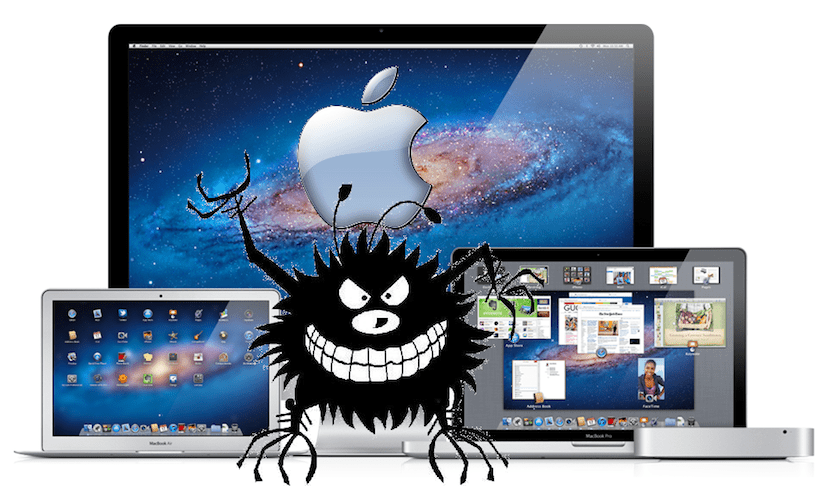
There is a false myth that Mac users are safe from all types of viruses on our computers, however, this has never been true, and it is becoming less and less. What is true is that malware affects Mac computers less than Windows computers, but despite this, threats have multiplied in recent years largely due to the increased popularity of Apple computers, and therefore also the growing interest of cyber criminals.
According to Panda Security, the number of threats affecting Apple Macs has quadrupled During the last years. Along with this conclusion, it has also developed a list of the greatest threats that, obviously, we must avoid.
Macs are not safe from malware
The volume of threats against Apple Macs it has quadrupled in recent years, from around 500 malicious programs detected in 2012 to more than 2200 in 2015, and the figure keeps going up. From Panda Labs they point to a very logical cause: Mac computers, as they are used by a greater number of people, also arouse greater interest from malware developers. It is a simple matter of profitability: what they invest in developing malware will be more profitable if it can affect a greater number of users.
Luis Corrons, director of Panda Labs, assures that “the myth that there are no viruses for Mac is history. In 2015 alone we have detected twice as much 'malware' for these operating systems as we detected a year earlier.
Main symptoms of an infected Mac
Much of this malware is deeply camouflaged, however, it is easy to at least suspect that something is wrong when our Mac "Begins to function excessively slowly" or when we realize "High CPU, memory, disk or network consumption"Corrons notes. That's when "you should suspect that your device might have been infected."
The most dangerous viruses for Mac
The Panda Security team has shared a list of the ten most dangerous Mac threats today. Remember that common sense is the best weapon so you should avoid clicking on suspicious email links, avoid installing apps from unofficial sites or better yet, download your apps exclusively from the Mac App Store.
The biggest threats for Mac users at the moment are, according to Panda Security, the following.
Wirelurker
Qualified as the most dangerous malware of all those detected in Panda Security. Although it only affects iOS devices, it spreads via USB and is capable of installing malicious apps and taking control of your iPhone or iPad.
Karanger
It is a "ransomware", that is, a malware capable of hijacking your Mac, leaving it completely useless until you agree to pay a ransom for it.
yontoo
It is an apparently harmless extension to download YouTube videos, which is installed in the browser to insert malicious advertising.
godgost
It is installed on your Mac through unofficial apps and is a Trojan with which they can steal all the information you have stored on your computer.
macvx
This is actually a PUP or Potentially Dangerous Program cataloged browser add-on that will flood your browser with ads.
Cointhief 2014
Another Trojan that installs malicious add-ons in the browser and steals the credentials of sites that support payment with bitcoins and / or dedicated to the exchange of bitcoins.
iworm 2014
It is a true "back door" that will serve up all your personal data to third parties.
Janicab
Malware that, through screens and audio recordings, takes over all your passwords to carry out Denial of Service attacks on other websites, hijack data, and so on.
laoshu
Through a false email that tells you that they have not been able to deliver a package, it will end up taking over your Mac.
macinstaller
It is an "old dog" among Mac users. It publishes advertising on legitimate sites that leads you to false ones where it informs you that your Mac is affected by a virus so you can install Mac Defender, a software that will take over all your data.

I think you would have to differentiate between viruses and Trojans.
Viruses install themselves on the system without user intervention and are self-replicating, Trojans take advantage of the user to install themselves and are not self-replicating.
That a virus is installed in Mac OS X is practically impossible thanks to the lodging in sandboxes of the applications, and much less in Mac OS Sierra that only supports applications of the Appstore or signed external.
In order to install an unsigned third-party application, it is necessary to deactivate Gatekeeper by selecting the option «From anywhere» that comes in the system preference «Security and Privacy» and which is always deactivated and the only way to activate it is through Terminal commands or closed applications for it. This means that, with Sierra, the entry of a Trojan is not possible for normal users and only ninja level users, who know what they are doing, could be in danger by activating the installation of unsigned applications.
You have said it rightly, the necessary authorization by the user is what makes the difference. If you come to a web page where it says that you have just won a million euros and that you download our fabulous program and give us your checking account details to access the payment ... well. Against that no operating system can defend you, only common sense
What a drag! But what is the solution, which antivirus is capable of providing safe protection?
For adware, which is very annoying but not dangerous, just run through the free Adwaremedic software that will remove these bugs from your browsers.
The IOS "virus" is not easy to enter your iPhone / iPad if you are a Mac user since this bug is transmitted to the iPhone via an infected PC.